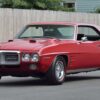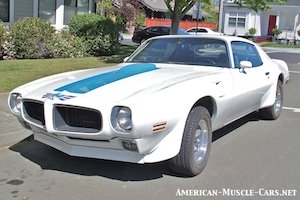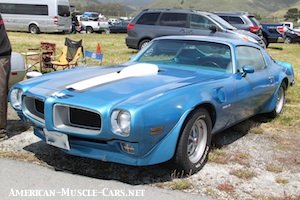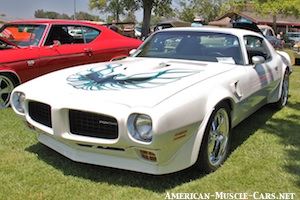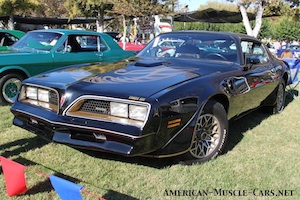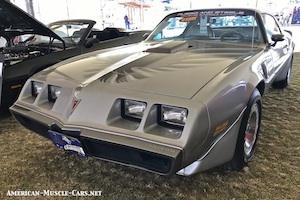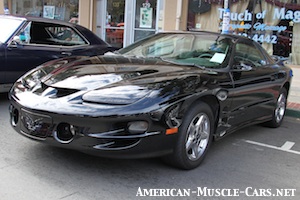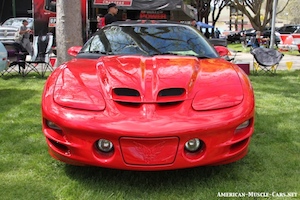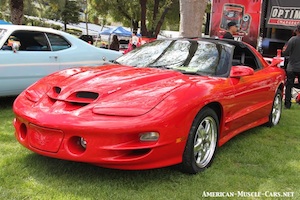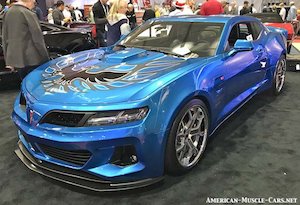Pontiac Trans Am

PONTIAC TRANS AM 1st-GENERATION: 1969
Pontiac was late to the Pony Car Party, following the Ford Mustang (the founding father of Pony Cars) by 3 years and its own stablemate, the Chevy Camaro by a few months with its own 1967 Firebird. Ford gave the Mustang a high-performance version in the Mustang GT, starting in the Mustang’s first full year, 1965. When the Camaro launched in the 1967 model year, it was quickly followed that same year by a high-performance variant also, the Z/28. For the time being, Pontiac made do with the Firebird Formula as its highest performance version. It took until 1969 to introduce the world to first Pontiac Trans Am, which despite the name was never actually intended for Trans Am racing. It’s smallest engine exceeded the 305-cubic-inch-limit. So Pontiac settled for paying the SCCA Trans Am series a $5.00 royalty on every Pontiac Trans Am sold. It was produced in limited numbers. In a flash, the first generation of Firebirds and Camaros was over.
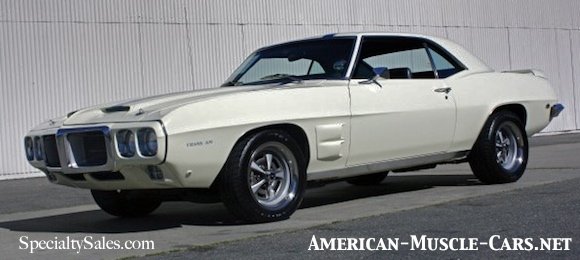
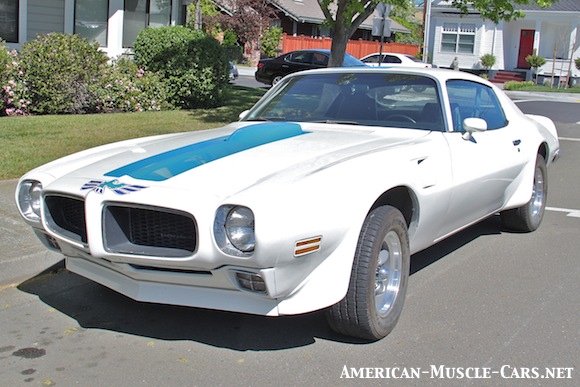
PONTIAC TRANS AM 2nd-GENERATION: 1970-1981
The Trans Am really came into its own during its second-generation. It took GM so long to engineer and tool up for the new Camaro and Firebird that the 1970 production near started late, curtailing 1970 production numbers. Too bad too, because 1970 was the peak of horsepower during the Golden Age of the Muscle Car, and by 1971 increasing smog regs, safety standards and unleaded gas was killing performance. Pontiac did its best to hold on to what it could, and was in fact the last of the Big 3 to mass-produce cars with big block engines. But, Pontiac wisely slanted the emphasis more toward European-style handling and really cool styling (how about that Screaming Chicken on the hood?). Chevy was so embarrassed by its crappy performance and so killed off the Z28 for one model year in 1976. Mopar was dead in the weeds by the mid-70s. Even the Corvette was wheezing around with 165 horsepower. The only real muscle car left with any balls was the Pontiac Trans Am with its big 400 V8 and gobs of good ol’ American torque.

PONTIAC TRANS AM 3rd-GENERATION: 1982-1992
The 3rd-gen Firebird and Camaro shed 500 pounds compared to the cars they replaced. Initially, engines and transmissions were carried over from the previous generation, all V8s being the 5.0 Liter (305 ci) Chevy V8. The real action started in 1985 with the introduction of Tuned Port Injection (TPI) 305 V8, with either the 700R4 4-speed automatic or a new 5-speed manual. The base Trans Am engine continued to be a 305 with a 4-barrel carb through the 1987 model year. Staring in 1988, all carburetors disappeared and the base Trans Am V8, while still the same 305, replaced the carb with a Throttle Body Injection System (TBI), which was reliable enough, but not very fast. But not matter, because in 1987 the 5.7 Liter (350ci) V8 with TPI was introduced with 230 horsepower, or 245 horses with the optional G92 package, featuring dual catalytic converters. The 5.7 was only available with an automatic, as the only 5-speed available at the time couldn’t handle the torque of the mighty 350. If you think about it, even the Corvette never got a 5-speed. They jumped straight from the 4+3 to a 6-speed. The Trans Am GTA launched in 1987 as the top-of-the-line Trans Am with premium leather interior and most of the options on normal TAs as standard equipment. The 3rd-gen was the first to feature the Firebird’s trademark hide-away headlights, a feature they would retain until the end.

PONTIAC TRANS AM 4th-GENERATION: 1993-2002
The 4th-generation of the Firebird and Camaro were never as well-received, or sold as well, as the 3rd-generation. Maybe it was changing times, changing markets, changing demographics. It certainly wasn’t for lack of content. The 1993 Trans Am launched with a 275-horse 5.7 LT1 V8 with either a 4-speed auto or a 6-speed manual. Everything was improved, handling and performance-wise. Unfortunately, a lot of people felt that the packaging of the car made it feel tight inside, and as before the luggage area out back was hopelessly impractical. But they were fast and they handled extremely well. Engine choices closely followed the Corvette’s with ever more powerful versions being added right up until both the Firebird and the Camaro were killed off in 2002 due to slow sales. The Firebird (including the Trans Am) never reappeared. In fact, Pontiac was shuttered in 2009, a victim of GMs bankruptcy. The Camaro finally made it back however, starting with a 5th-generation in 2010 and now a 6th-gen Camaro has just been released in 2016. The Pontiac Trans Am may be gone, but it’s not forgotten.
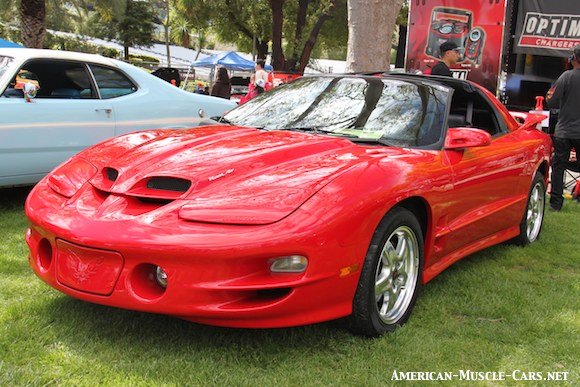
Pontiac Trans Am YEAR-BY-YEAR
First year of the 2nd-generation. Radical new look that would stay in play until 1981. Pontiac is ahead of their time, eliminating chromed bumpers.
First year of the 2nd-generation. Radical new look that would stay in play until 1981. Pontiac is ahead of their time, eliminating chromed bumpers.
Last year for the graceful looks of the early 2nd-gen. Even smogged-out the big 455 4bbl still kicked out the jams. Trans Am was just about the only true Muscle Car left in the 70s.
1974 TRANS AM
First year for the ‘cattle-catcher’ front end, last year for the 455 Super Duty V8.
Despite a drastic drop in performance across the board, the mighty Trans Am continues to beat the odds. They weren’t fast, but they were faster than just about anything else at the time.
First year for the new look. Special Black Edition debuts & sells like hotcakes thanks to the movie “Smokey & the Bandit”.
Pontiac was still building muscle cars. The smallest engine you could get in a ’78 T/A was a 400 big block. Gold Special Edition debuts. Black & Gold “Smokey & the Bandit” paint combo continues. New T-Tops.
1979 TRANS AM 10th Anniversary Edition
Big & bad, the T/A is one of the last muscle cars standing by the end of the 70s, & the ONLY one with a big block, the 6.6L (403 cid) Olds V8.
Early in the 3rd-generation, the hottest engine in the lineup was the 5.0 H.O. (High Output) V8 wheezing out 190hp.
The 3rd-gen is lighter & with new TPI V8s, faster than before. The GTA, or Grand Trans Am was the premium version. Top engine was the 5.7 TPI V8 w/245hp, same as the ’87 Corvette.
The GTA was the top-line Trans Am w/5.7, leather, special wheels, emblems, etc. They got the best of everything!

1999 TRANS AM 50th ANNIVERSARY
Pontiac made just 1,750 50th Anniversary Coupes to celebrate the Trans Am’s 50th birthday. The all-white T/A had a blue stripe meant to ape the 1969 Trans Am.
4th-gen Trans Ams are amazing! Corvette power, great handling, aggressive styling, & they were seriously fast!
’02 was the last year for Firebird & Trans Am production…and this car is literally the last Trans Am to roll off the assembly line!
YouTube Video: “The Last Trans Am”.
A virtual walk-around, up close & personal with this drop-dead gorgeous 2002 Trans Am. You’ve heard the story: this is supposed to be the last Trans Am to roll off the assembly line.
2017 TRANS AM
Wait…what? You heard right. Trans Am Worldwide is building new Trans Ams out of the Alpha-platform 6th-gen Camaro. Very convincing job.




